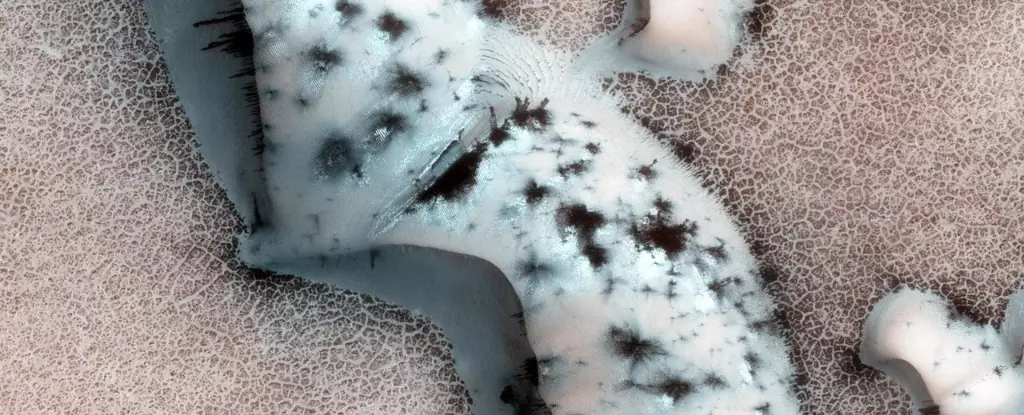Mars, often portrayed as a cold and barren wasteland, has untold mysteries and rare beauties that continue to intrigue scientists and space enthusiasts alike. The Red Planet, with its thin atmosphere and captivating geologic features, presents a unique contrast to Earth, sparking curiosity about its environment and climatic phenomena. One of the most striking examples of Martian beauty is the seasonal formation of carbon dioxide (CO2) geysers, a feature that, while perhaps alien, showcases a dynamic interaction between the planet’s seasonal changes and its surface geology.
The Martian climate is characterized by extreme seasonal variations, particularly polar seasons. During the harsh Martian winter, roughly 95% of the planet’s atmosphere, composed predominantly of carbon dioxide, undergoes a dramatic transformation. As temperatures plummet, CO2 in the atmosphere freezes and settles on the polar regions, creating a thick crust of solid ice. This layer, while seemingly lifeless, becomes a critical player in the planet’s summer thaw. As spring emerges, warming temperatures lead to the sublimation of the ice, allowing sunlight to penetrate the translucent layer. This process gradually warms the ground beneath, providing a fertile ground — quite literally — for extraordinary geological activity.
The interplay between heat and pressure eventually gives rise to a series of spectacular geysers. As the frozen CO2 sublimates, high-pressure gas builds up beneath the solid surface in pockets, akin to a shaken soda bottle waiting to erupt. Once these pockets exceed a certain threshold, they explosively release gas, creating geysers that can shoot CO2 at such great velocities that they spread dark material across the frozen landscape. Captured by the HiRISE camera aboard NASA’s Mars Reconnaissance Orbiter in 2018, these geysers present vivid snapshots of an ornately detailed Martian surface, with some eruptions casting shadows as large as one kilometer wide.
The darker spots formed from these geysers are not merely accidental; they have a structured elegance reminiscent of intricate art patterns. Some of these eruptions create peculiar formations that resemble spiders, a phenomenon now referred to as araneiform terrain. These motifs, which cluster together and give the surface a distinctly wrinkled appearance, were a source of fascination for scientists. Laboratory recreations of these patterns have provided insights into their formation, revealing the dynamic forces at play beneath the icy surface.
Central to comprehending these intriguing geological features is the Keiffer model. Proposed by researchers studying the phenomenon, this model suggests that the seasonal CO2 caps on Mars behave like a translucent, impermeable barrier. As the gas beneath it builds up due to sublimation, it creates high-pressure pockets. Eventually, these pockets cause the ice to rupture, resulting in explosive geysers that eject sand-sized particles and reshape the surrounding landscape.
These geological wonders challenge our perceptions of beauty and novelty in natural landscapes. Earth has long been celebrated for its diverse and picturesque scenery, often described poetically as a sanctuary for the senses. While nothing can quite compare to the rich biosphere of Earth, Mars, through its unique and exotic processes, holds geological features that are unparalleled, inviting humanity to contemplate the cosmic differences between our two worlds.
In the grand tapestry of the universe, each celestial body captures its own essence. Mars, with its stunning CO2 geysers and intricate surface patterns, exemplifies a beauty born from harshness and isolation. These processes, without parallel on Earth, challenge us to rethink how we define beauty in a cosmic context. Much like the poets celebrating Earth’s landscapes, we ought to honor the uniqueness of Mars, as it tells a story of change and resilience in an atmosphere where life, as we understand it, does not exist. Exploring these Martian phenomena not only expands our scientific understanding but also enriches our appreciation for the diverse expressions of beauty found across the cosmos.

